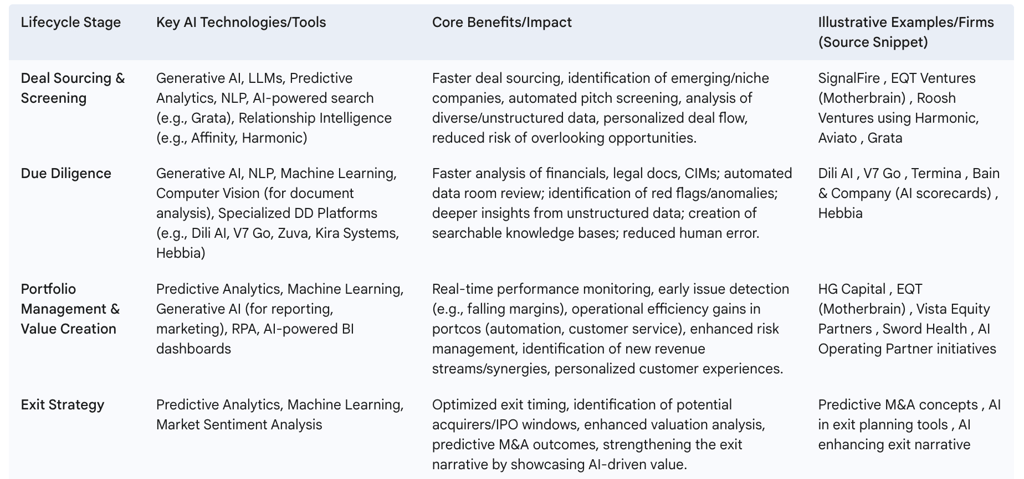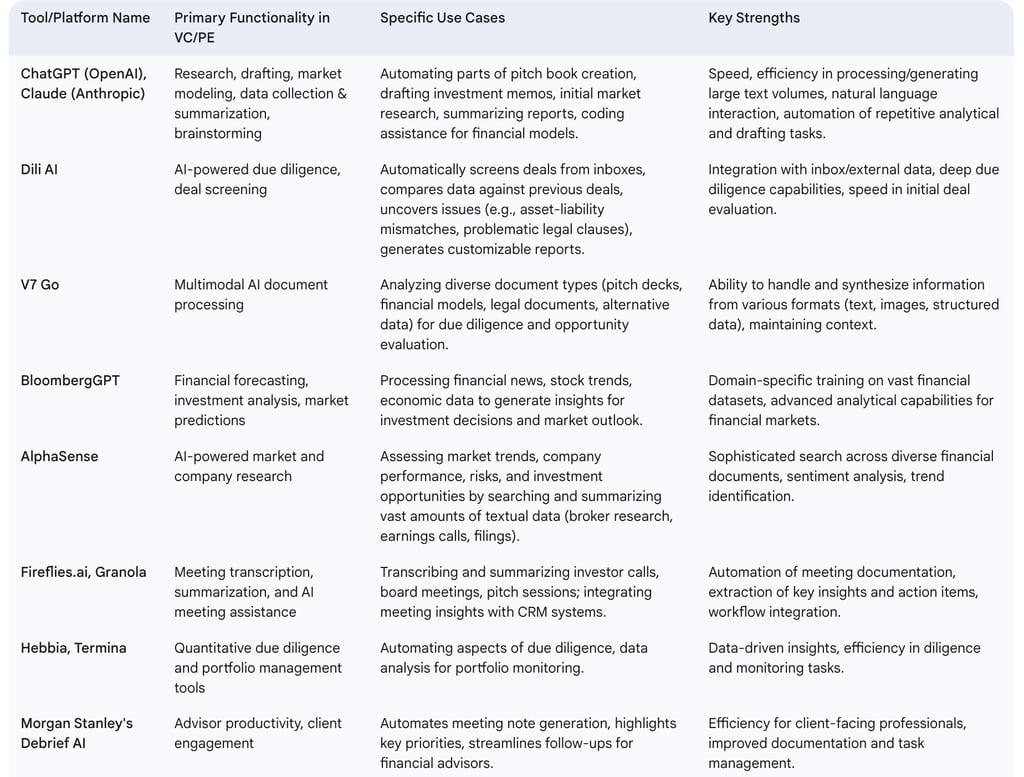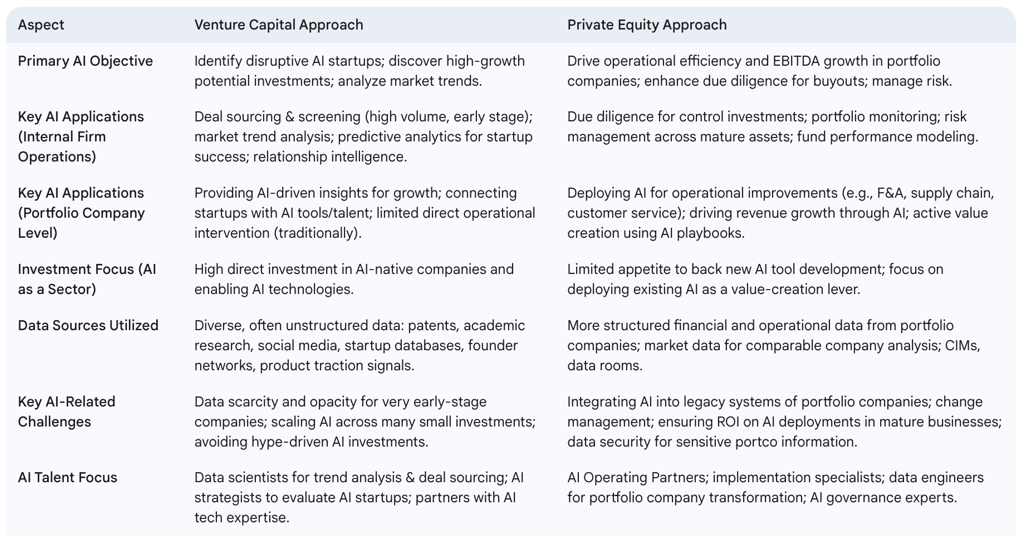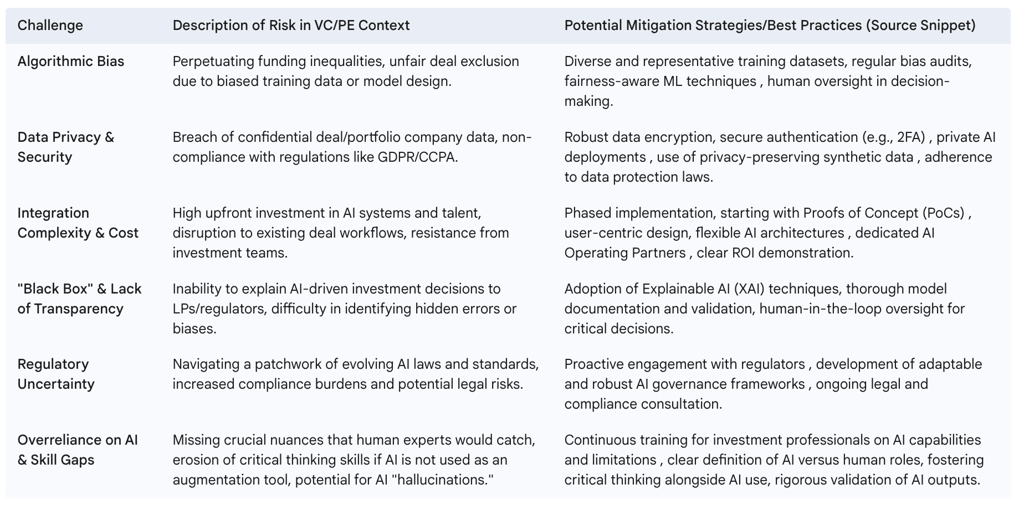AI-Driven Investments: How ChatGPT is Transforming Venture Capital and Private Equity


Artificial Intelligence (AI), encompassing a rapidly evolving suite of technologies including sophisticated generative AI models like ChatGPT, is no longer a nascent concept but a potent force actively reshaping the operational and strategic landscapes of Venture Capital (VC) and Private Equity (PE). The adoption of AI within these sectors has surged, moving from experimental phases to deep integration into core investment processes. This report provides an in-depth analysis of AI's transformative impact, examining its applications across the entire investment lifecycle – from deal sourcing and due diligence to portfolio management, value creation, and exit strategies.
The analysis reveals that while both VC and PE firms are aggressively leveraging AI, their approaches and primary objectives differ, reflecting their distinct investment mandates. VC firms are notably active in investing in AI-native companies and utilizing AI to identify high-growth potential and emerging market trends. In contrast, PE firms are predominantly focused on deploying AI as a powerful lever for operational efficiency and value enhancement within their portfolio companies. The benefits are tangible, manifesting as significantly improved efficiency, augmented decision-making capabilities, and new avenues for competitive differentiation. However, this technological revolution is not without its complexities. Critical challenges include ensuring data quality and security, navigating the ethical implications of algorithmic bias, managing the high costs and complexities of implementation, and addressing the evolving regulatory environment. Furthermore, the integration of AI is profoundly altering the human element in investment, necessitating new skillsets and restructuring roles within firms.
The speed and breadth of AI adoption underscore a fundamental shift: firms failing to develop and implement a coherent AI strategy risk significant competitive disadvantages in an increasingly data-driven and algorithmically-influenced market. While prominent tools like ChatGPT capture attention, the true transformation is powered by a diverse array of AI technologies, including predictive analytics, machine learning, and natural language processing. A holistic understanding and strategic deployment of this broader AI toolkit are therefore crucial for navigating the future of private market investing, where AI is poised to become an indispensable component of sustained success and value generation.
I. The AI Revolution in Investment: A Paradigm Shift for VC and PE
A. The Current Landscape: Rapid AI Adoption and Integration
The integration of Artificial Intelligence into the core fabric of Venture Capital and Private Equity operations marks a significant paradigm shift. No longer confined to the realm of experimentation, AI has transitioned into a fundamental component of competitive strategy for a growing majority of firms. Recent data underscores this rapid assimilation; a survey in late 2024 indicated that 82% of PE and VC firms were actively utilizing AI, a dramatic escalation from 47% just a year prior. This swift uptake signals a recognition that AI tools are not merely "nice-to-have" enhancements but critical infrastructure for navigating the complexities of modern investment.
Further evidence from FTI Consulting reveals that 75% of surveyed PE firms have either begun using or plan to use AI to drive value within their portfolios in the current year, with widespread application in managing deal flow and evaluating individual opportunities already apparent. This trend is not isolated to specific AI categories; the adoption of generative AI (GenAI) has been particularly forceful, with organizational use in at least one business function surging from 33% to 71% between 2023 and 2024, while overall AI use in organizations jumped from 55% to 78% in the same period.
The near-universal adoption of generative AI, with a 2025 survey indicating 100% usage among CFOs and PE respondents , coupled with the high overall AI integration rates, suggests that the initial barriers to accessing and utilizing basic AI tools are diminishing. However, this widespread availability also implies that mere adoption is rapidly becoming "table stakes". The true competitive differentiation will likely emerge not from simply possessing AI capabilities, but from the strategic depth and efficacy of their implementation. As firms move beyond basic applications, the ability to weave AI into unique workflows, cultivate proprietary insights, and synergize AI with human expertise will define market leaders.
Interestingly, while PE firms were early adopters and maintain high confidence in AI, there's an indication of a slight moderation in their AI investment plans for 2025 compared to the previous year. This could signal a transition from a phase of broad AI experimentation towards more focused, ROI-driven initiatives. It may also reflect an acknowledgment that the practical realities of deploying and scaling AI can be more challenging and resource-intensive than initially anticipated, prompting a more discerning approach to future AI expenditure. This contrasts with midsize companies, which appear to be ramping up their AI investment plans , possibly still in an earlier adoption phase.
B. Defining the AI Toolkit: From Generative AI (ChatGPT and beyond) to Predictive Analytics
The AI revolution in VC and PE is not driven by a single technology but by a diverse and expanding toolkit. While generative AI, exemplified by models like ChatGPT, has garnered significant attention for its ability to create content and interact in natural language , it is part of a broader suite of AI capabilities transforming investment processes. This suite includes Large Language Models (LLMs), which power many generative AI applications and are adept at processing and understanding vast amounts of text ; Natural Language Processing (NLP), enabling machines to interpret and derive meaning from human language in documents, reports, and communications ; machine learning (ML) algorithms that identify patterns and make predictions from data ; and predictive analytics, which leverage historical and real-time data to forecast future trends and outcomes.
A particularly crucial development for the investment sector is the rise of "multimodal AI platforms". Investment workflows are inherently complex, involving the analysis of diverse document types, from PowerPoint pitch decks and Excel financial models to PDF legal agreements and alternative data sources like customer feedback or social media sentiment. Multimodal AI systems, such as V7 Go, are designed to handle this complexity, processing and synthesizing information from these varied formats while maintaining the contextual understanding vital for sound investment decisions. This capability represents a significant leap beyond traditional AI, which often specialized in a single data type. The future of AI in finance likely lies in such integrated platforms that can provide a holistic view from disparate data sources, rather than a collection of standalone, specialized tools.
Furthermore, the convergence of AI's analytical power with "relationship intelligence" platforms is pointing towards a hybrid future. Tools like Affinity are being used in conjunction with AI to map and analyze professional networks, automate communication logging, and identify warm introduction paths. Deal-making in VC and PE is deeply rooted in human networks and relationships – an area often considered intangible and difficult for AI alone to navigate. By digitizing and structuring network data, relationship intelligence systems provide a new data layer that AI can analyze. This synergy suggests AI is not only automating analytical tasks but is also beginning to augment the "art" of deal-making, providing data-driven insights into one of the most human-centric aspects of the investment world. This holistic approach, combining various AI technologies, defines the evolving toolkit that firms are deploying to gain a competitive edge
II. AI Transforming the Investment Lifecycle
The infusion of Artificial Intelligence is systematically reshaping every stage of the venture capital and private equity investment lifecycle. From the initial hunt for promising deals to the final exit strategy, AI tools are providing unprecedented capabilities for speed, depth of analysis, and data-driven decision-making.
A. Deal Sourcing and Screening: Uncovering Opportunities with Precision
The traditionally labor-intensive processes of deal sourcing and screening are undergoing a profound transformation due to AI. Generative AI and LLM-powered tools are now central to identifying and evaluating investment opportunities with greater speed and precision. These systems can process thousands of startup pitches monthly, analyzing diverse data streams that range from patent filings and financial statements to social media trends and news sentiment to identify emerging companies, often before they appear on mainstream radar. This capability allows investors to "get access to startups before they go big".
AI platforms function like "hyper-intelligent tracking dogs," methodically combing through vast digital landscapes to locate targets. For instance, AI-driven search tools enable users to define a target company archetype with specific corporate and financial criteria, and then scan the internet for similar entities, returning detailed profiles and contact information almost instantaneously. Natural Language Processing (NLP) plays a crucial role by interpreting investor interests and suggesting startups based on nuanced factors like market trends, founder backgrounds, and subtle growth indicators such as social media momentum or hiring surges. Leading VC firms like SignalFire and EQT Ventures have built proprietary AI platforms to automate the identification of promising startups by continuously analyzing data from millions of sources. Similarly, tools like Grata are being employed for AI-powered deal origination.
The capacity of AI to analyze diverse and unstructured data, including founder backstories or social media sentiment , is particularly significant. This democratizes access to insights that were previously the domain of firms with extensive research teams or exclusive networks. As a result, even single angel investors and small syndicates can now leverage analytical power comparable to that of large institutions, potentially leveling the playing field. This implies a shift where competitive advantage in sourcing may depend less on firm size and more on the intelligent application of AI.
Moreover, AI is introducing a new level of personalization to deal flow. Systems can learn an investor's preferences over time, observing the types of startups they engage with and those they pass on. This allows AI to curate future recommendations with increasing relevance, akin to "having a Spotify for startup deals". Such personalization reduces the noise inherent in traditional deal sourcing, improving the quality of opportunities reviewed and allowing investors to focus their time on the most promising and thesis-aligned ventures. This ultimately leads to not just a higher volume of sourced deals, but a higher quality of deal flow, potentially enhancing investment outcomes. In a market where missing a single high-potential deal can significantly impact returns, AI provides a crucial competitive edge by accelerating screening and reducing the risk of overlooking promising investments.
B. Due Diligence Reimagined: AI for Deeper, Faster Insights
The due diligence phase, traditionally a meticulous and time-consuming process, is being reimagined through the application of AI. Generative AI and specialized platforms are enabling firms to conduct deeper analyses of potential investments with significantly enhanced speed and efficiency. AI tools can automate large segments of the due diligence checklist, including the analysis of financial models, verification of founder backgrounds, review of legal documents, and scanning for public relations or legal red flags.
Platforms like Dili AI, an AI-powered diligence tool, can automatically screen deals identified in investor inboxes, extract relevant information from preliminary materials, and compare this data against structured databases of previous deals. This not only accelerates deal evaluations but also aids in identifying comparable companies and potential red flags early in the process. Such systems can delve into a target company's data room to uncover issues that might not be immediately apparent, such as asset-liability mismatches or problematic legal clauses. Similarly, multimodal AI platforms like V7 Go can process a wide array of document formats—from confidential information memoranda (CIMs) and financial statements to legal contracts—extracting critical business and financial metrics.
A fundamental shift enabled by AI in due diligence is the creation of "structured, searchable knowledge bases" from complex deal documents. Instead of reactively reviewing documents for each new deal, AI can transform these materials into a valuable, reusable data asset. Every contract clause, financial statement, and compliance requirement can become instantly accessible and cross-referenced. This facilitates rapid comparison with new deals, identification of precedents, and a cumulative learning effect within the firm, potentially providing a compounding knowledge advantage over time.
The emergence of specialized AI due diligence platforms that integrate with both external financial data sources (like Capital IQ or Pitchbook) and internal communication channels (such as inbox scanning for deal-related emails) signifies a move towards an "always-on" diligence capability. This continuous, automated initial assessment of opportunities can significantly compress deal timelines and allow firms to evaluate a larger volume of deals more thoroughly. The reduced friction and upfront cost of looking at a deal mean that investment teams are indeed examining more opportunities. This speedier due diligence, analyzing thousands of companies in seconds, allows managers to move faster on high-potential opportunities. Tools like Zuva, Kira Systems, Hebbia, and Termina are also contributing to this transformation. Bain & Company, for example, has adopted an AI-driven scorecard-based approach in its due diligence process for more precise and rapid assessments.
C. Portfolio Management and AI-Driven Value Creation
Post-investment, AI is becoming an indispensable tool for monitoring portfolio company performance, identifying operational efficiencies, driving value creation initiatives, and managing risk. AI-powered platforms enable continuous, real-time tracking of key performance indicators (KPIs), financial metrics, operational efficiency, and market dynamics. Nearly 60% of PE managers utilize AI tools for early alerts, detecting issues like declining margins or supply chain disruptions before they escalate.
Generative AI is reshaping how firms optimize their investments by analyzing vast datasets to pinpoint performance drivers and inefficiencies, allowing managers to make data-driven adjustments. Beyond monitoring, AI is opening new avenues for value creation directly within portfolio companies. Applications range from automating operational processes and optimizing pricing strategies to enhancing customer experiences through personalized marketing and service. For example, AI-powered analytics can help companies identify customer preferences and tailor marketing strategies, leading to increased engagement and sales. HG Capital serves as a notable example, leveraging AI both to assess potential acquisitions and to enhance value creation in its existing portfolio, including supporting a company specializing in AI-based data analytics for retail businesses.
This evolution signifies AI's shift from a passive monitoring instrument to an active "value creation engine." Investment firms are increasingly acting as tech-enablement partners, not just capital providers. This transformation is evidenced by the emergence of roles like the "AI Operating Partner" within PE firms, dedicated to spotting, vetting, and scaling AI use cases across portfolio companies to accelerate EBITDA expansion. These partners often come with backgrounds as entrepreneurial business leaders, technical product leaders, or executive technology leaders who have experience deploying AI solutions. Early wins are seen in transforming core business models (e.g., AI in healthcare agent matching patients to caregivers) and achieving significant operational efficiencies in functions like Finance & Accounting (F&A), customer service, and marketing. Vista Equity Partners, for instance, systematically integrates generative AI and code-assist tools across its portfolio to improve product development cycles and operational efficiency without reducing workforce size.
Furthermore, AI's ability to foster synergies within an existing portfolio and identify "repeatable use cases that can be scaled" across different portfolio companies suggests a more programmatic approach to value creation. By systematically analyzing data across multiple holdings, AI can find common challenges, opportunities, or potential collaborations. This allows for the development of "playbooks" that can be deployed across similar companies, leading to more consistent value uplift across a fund. This industrialized approach to value creation, where successful AI strategies are replicated, can contribute to higher overall fund returns through systemic improvements rather than relying solely on the idiosyncratic success of individual companies. EQT's "Motherbrain" tool is used not only for deal sourcing but also for monitoring and supporting portfolio companies.
D. Optimizing Exit Strategies with AI
AI is also beginning to influence the final stage of the investment lifecycle: optimizing exit strategies. Predictive analytics and machine learning models can assist in planning and timing exits by analyzing market conditions, identifying potential acquirers or favorable IPO windows, and refining valuation expectations. AI can sift through historical data from thousands of past deals to predict potential M&A outcomes, moving towards a "predictive M&A" landscape.
AI tools can analyze comparable deals, industry benchmarks, and financial forecasts to help establish optimal valuations for portfolio companies preparing for an exit. Moreover, AI can predict the likelihood and timing of specific exit events, such as acquisitions or IPOs, enabling firms to plan their strategies more effectively.
Beyond the analytical aspects of timing and valuation, AI's role is expanding to become part of the "exit narrative" itself. When preparing a portfolio company for sale, operating partners can leverage AI-driven improvements to demonstrate tangible value creation. Showcasing successful AI integration and highlighting the future potential for AI-driven growth can significantly enhance a company's attractiveness to potential buyers and potentially command higher exit multiples. A portfolio company with embedded, effective AI demonstrates innovation, efficiency, and data-driven capabilities, making it a more compelling asset. Thus, AI becomes a key selling point, influencing not just the mechanics of an exit but also the perceived quality and future growth trajectory of the investment.
The following table summarizes the key applications of AI across the investment lifecycle:
Contact Us Today
Contact us for Generative AI solutions and improved customer experiences. Our team is ready to help your business succeed.








